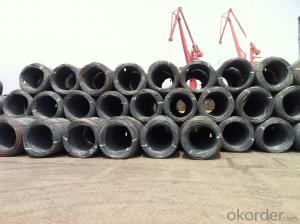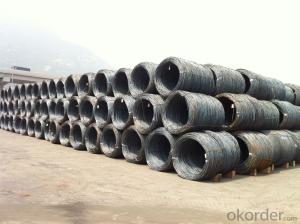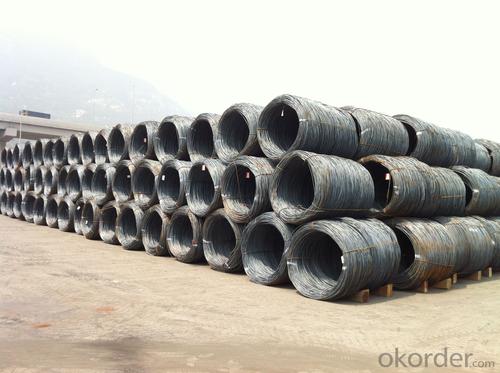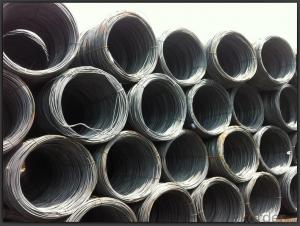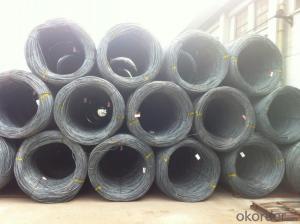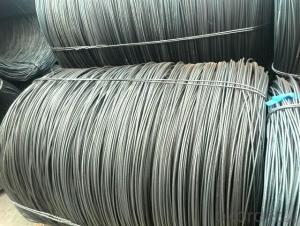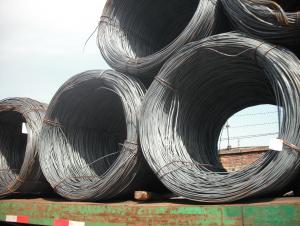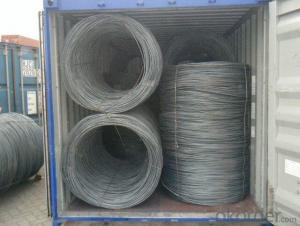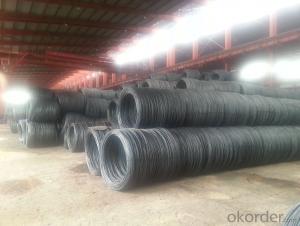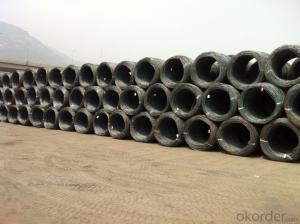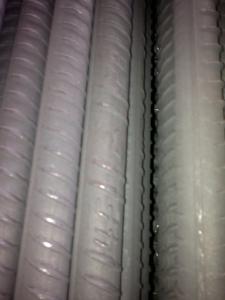Hot Rolled Wire rods with Grade SAE1008B and High Quality
- Loading Port:
- Tianjin
- Payment Terms:
- TT OR LC
- Min Order Qty:
- 25 m.t
- Supply Capability:
- 10000 m.t/month
OKorder Service Pledge
OKorder Financial Service
You Might Also Like
OKorder is offering Carbon Steel Wire Rod at great prices with worldwide shipping. Our supplier is a world-class manufacturer of steel, with our products utilized the world over. OKorder annually supplies products to European, North American and Asian markets. We provide quotations within 24 hours of receiving an inquiry and guarantee competitive prices.
Product Applications:
After hot-rolled the products shaped into coil . Since most of the products are round, it is generally called wire rod. Carbon steel wire rod is widely used in construction and manufacturing. Carbon steel wire rod is mainly used for reinforcement of reinforced concrete and welded structure or reprocessed (roberts , nail, etc.) materials, especially used to produce wire drawing, welding electrode, nails, spring, electronic, precise machinery parts and so on.
Product Advantages:
OKorder's Carbon Steel Wire Rod are durable, strong, and resist corrosion.
Main Product Features:
· Premium quality
· Prompt delivery & seaworthy packing (30 days after receiving deposit)
· Corrosion resistance
· Can be recycled and reused
· Mill test certification
· Professional Service
· Competitive pricing
Product Specifications:
Chemical Composition:
Please kindly find our chemistry of our material based on SAE1006/SAE1008 as below for your information
Grade | Chemical Composition (%) | |||||
C | Mn | S | P | Si | B | |
SAE1006 | 0.03~O.07 | 0.32max | 0.045max | 0.040max | 0.30max | 0.0008min |
Mechanical properties | ||||||
Yield strength(N/mm2) | Tensile strength(N/mm2) | Elongation (%) | ||||
250-280 | 350-380 | ≥32 | ||||
Grade | Chemical Composition (%) | |||||
C | Mn | S | P | Si | B | |
SAE1008 | 0.10max | 0.3~0.50 | 0.050max | 0.040 max | 0.15max | 0.0008 min |
Mechanical properties | ||||||
Yield strength(N/mm2) | Tensile strength(N/mm2) | Elongation (%) | ||||
≥195 | 315-430 | ≥30 | ||||
FAQ:
Q1: Why buy Materials & Equipment from OKorder.com?
A1: All products offered by OKorder.com are carefully selected from China's most reliable manufacturing enterprises. Through its ISO certifications, OKorder.com adheres to the highest standard and a commitment to supply chain safety and customer satisfaction.
Q2: How do you guarantee the quality of products?
A2: We have established an advanced quality management system which conducts strict quality tests at every step, from raw materials to the final product. At the same time, we provide extensive follow-up service assurances as required.
Q3: Can stainless steel rust?
A3: Stainless does not "rust" as you think of regular steel rusting with a red oxide on the surface that flakes off. If you see red rust it is probably due to some iron particles that have contaminated the surface of the stainless steel and it is these iron particles that are rusting. Look at the source of the rusting and see if you can remove it from the surface.
Q4:What's your payment terms ?
A4:Mostly,we collect the money by T/T and LC at sight . We also accept time LC at 90/120 days sight.
Image :
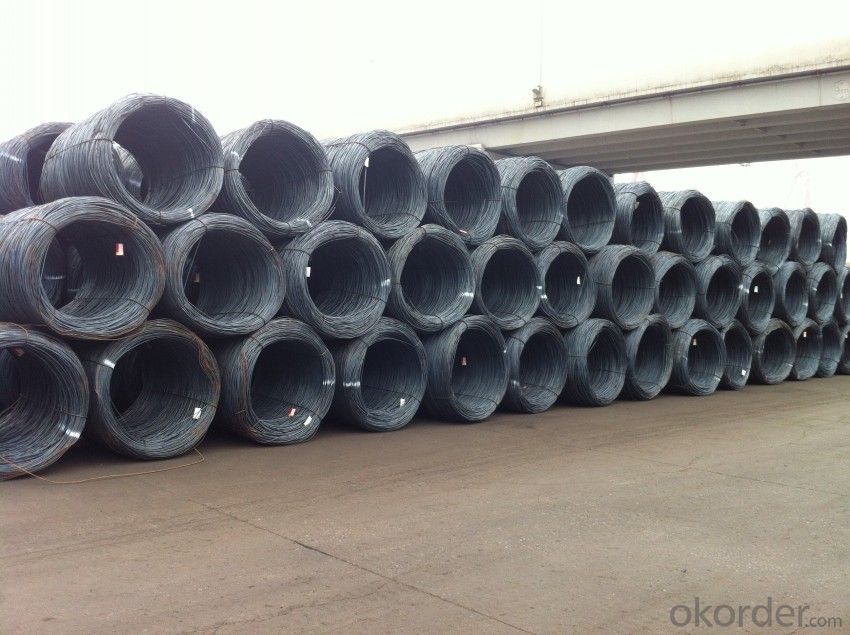
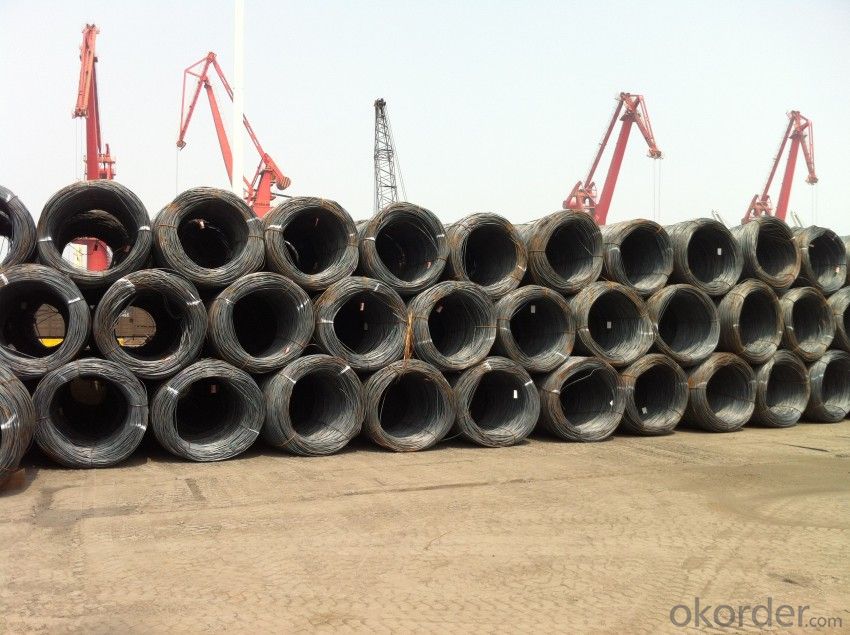
- Q: How does the ductility of steel wire rod vary with different wire drawing processes?
- The ductility of steel wire rod can change depending on the wire drawing technique utilized. Wire drawing, a metalworking process in which a metal wire is pulled through a die to decrease its diameter and increase its length, is responsible for this variation. The ductility of the steel wire rod refers to its capacity to deform under tensile stress without fracturing. The ductility of the steel wire rod can be influenced by different wire drawing techniques due to several factors, including the degree of diameter reduction, the number of drawing passes, and the temperature employed during the process. Generally, as the wire's diameter decreases during wire drawing, the ductility of the steel wire rod increases. This is because reducing the diameter raises the dislocation density in the steel's crystal lattice, allowing for greater plastic deformation before fracture occurs. The number of drawing passes also has an impact on the ductility of the steel wire rod. Multiple drawing passes permit a more controlled reduction in diameter, resulting in a more even distribution of dislocations and an increase in ductility. Moreover, the temperature during the wire drawing process can affect the ductility of the steel wire rod. Higher temperatures can enhance ductility by reducing the steel's strength, allowing for more deformation before fracture. Nevertheless, excessive heat can have a negative impact on the steel's microstructure and reduce its ductility. To sum up, the ductility of steel wire rod can differ depending on the wire drawing technique employed. Factors such as the degree of diameter reduction, the number of drawing passes, and the temperature during the process all contribute to determining the final ductility of the wire.
- Q: What are the different types of steel wire rod coatings used for anti-corrosion properties?
- Steel wire rod coatings are commonly used to prevent corrosion. There are various types of coatings available for this purpose. 1. Zinc Coatings: Zinc coatings, like galvanized coatings, are widely used for their anti-corrosion properties. These coatings create a protective layer of zinc on the steel wire rod surface, acting as a barrier against corrosion. Zinc coatings can be applied through hot-dip galvanizing or electroplating. 2. Aluminum Coatings: Another type of coating used for anti-corrosion is aluminum coatings. These coatings can be applied through hot-dip aluminizing or thermal spraying. They form a protective layer that prevents contact between the steel wire rod and corrosive substances. 3. Epoxy Coatings: Epoxy coatings, a type of organic coating, are commonly used for anti-corrosion purposes. They are applied as a liquid and then cured to create a hard and durable protective layer on the steel wire rod surface. Epoxy coatings offer excellent resistance against corrosion and can withstand harsh environments. 4. Polymer Coatings: Polymer coatings, such as polyethylene or polypropylene coatings, are frequently used for anti-corrosion properties. These coatings are typically applied through extrusion or powder coating. Polymer coatings provide a protective layer that is resistant to chemicals, moisture, and other corrosive elements. 5. Ceramic Coatings: Ceramic coatings are highly resistant to corrosion and wear. They are applied through thermal spraying or chemical vapor deposition. Ceramic coatings create a hard and dense layer on the steel wire rod surface, offering excellent protection against corrosion. Choosing the right coating depends on factors such as the environment, operating conditions, and desired level of corrosion resistance. Each type of coating has its own advantages and limitations, so it is crucial to select the most suitable one for long-term anti-corrosion protection of the steel wire rod.
- Q: What are the major challenges faced by the steel wire rod industry?
- Today's market presents several major challenges for the steel wire rod industry. Among these challenges, the fluctuation in raw material prices, particularly iron ore and coal, stands out. The production of steel wire rods heavily relies on these inputs, and any significant price increase can have a substantial impact on the overall cost of production. Additionally, the industry faces intense global competition, both domestically and internationally. To stay competitive, steel wire rod manufacturers must constantly improve their production efficiency, reduce costs, and enhance product quality. Moreover, the industry must address environmental regulations and sustainability concerns. The energy-intensive processes involved in steel wire rod production can lead to high carbon emissions. To meet the increasing demand for sustainability, manufacturers must invest in cleaner technologies and adopt eco-friendly practices to reduce their carbon footprint. Furthermore, fluctuating demand for steel wire rods poses a challenge. The demand for these rods in sectors such as construction, automotive, and manufacturing is subject to economic cycles and external factors. Manufacturers must closely monitor market trends and adjust their production accordingly to avoid overproduction or underutilization of capacity. In addition, technological advancements present a challenge for the industry. With the rise of automation and digitalization, steel wire rod manufacturers must invest in advanced technologies to improve production efficiency, reduce downtime, and enhance product quality. However, this requires significant capital investment and skilled labor, which can be a challenge for some companies. Finally, the industry must address the issue of counterfeit products. Counterfeit steel wire rods can pose safety risks to end-users. Manufacturers must implement strict quality control measures and collaborate closely with regulatory authorities to prevent the circulation of counterfeit products in the market. In conclusion, the steel wire rod industry is confronted with challenges such as fluctuating raw material prices, intense global competition, environmental regulations, fluctuating demand, technological advancements, and the issue of counterfeit products. Overcoming these challenges necessitates continuous innovation, strategic planning, and a focus on sustainability to ensure the long-term success of the industry.
- Q: How are steel wire rods used in the production of wire coat hangers for hanging clothes?
- Steel wire rods are used in the production of wire coat hangers as they serve as the primary material for creating the hanger's structure. The rods are bent and shaped to form the hanger's traditional triangular shape, allowing it to support and hold clothes securely.
- Q: What are the common applications of deformed steel wire rod?
- Deformed steel wire rods are commonly used in a variety of applications such as construction, reinforcement of concrete structures, manufacturing of nails, wire mesh, fencing, and various other industrial purposes.
- Q: What are the different microscopy techniques used for steel wire rod analysis?
- Steel wire rod analysis can be performed using several microscopy techniques, which offer valuable insights into the microstructure, composition, and defects of the wire rod. 1. Utilizing optical microscopy, researchers can observe the wire rod's microstructure by employing visible light. This technique allows for the examination of grain size, grain boundaries, and visible defects like cracks or inclusions. 2. Scanning Electron Microscopy (SEM) involves directing a focused beam of electrons onto the wire rod's surface to capture high-resolution images. Through SEM, one can gather information about surface morphology, elemental composition, and the presence of surface defects or contaminants. 3. Transmission Electron Microscopy (TEM) is a powerful technique that involves passing a beam of electrons through a thin section of the wire rod to obtain detailed images of its internal microstructure. TEM provides information about crystal structure, grain boundaries, and the presence of atomic-level precipitates or defects. 4. Electron Backscatter Diffraction (EBSD) combines SEM with crystallography to determine the wire rod's orientation and grain structure. This technique offers insights into crystallographic texture, grain size distribution, and any deformation or recrystallization that might have occurred during processing. 5. X-ray Diffraction (XRD) involves directing X-rays onto the wire rod's surface to analyze its crystal structure. XRD provides information about phase composition, crystallographic orientation, and any residual stress or strain present. 6. Atomic Force Microscopy (AFM) employs a small probe to scan the wire rod's surface and capture high-resolution images. By utilizing AFM, researchers can gather information about surface topography, roughness, and the presence of surface defects such as scratches or pits. By employing these various microscopy techniques, researchers and engineers in the steel industry can develop a comprehensive understanding of microstructure, composition, and defects in steel wire rods. This understanding is essential for quality control, process optimization, and material development purposes.
- Q: What are the common industry competencies for steel wire rod manufacturers?
- Some common industry competencies for steel wire rod manufacturers include expertise in steel production and processing, knowledge of market trends and customer demands, ability to meet quality and safety standards, efficient supply chain management, strong technical skills in wire rod manufacturing processes, and the ability to innovate and adapt to changing industry needs.
- Q: How is steel wire rod tested for straightness?
- Steel wire rod is tested for straightness using various methods. One common method is the visual inspection, where the rod is visually examined for any bends or curves. Another method is the use of a straightening machine, which applies pressure and force to straighten any bends in the wire rod. Additionally, specialized instruments such as straightness testers or laser-guided systems can be used to measure and verify the straightness of the steel wire rod accurately.
- Q: What are the factors affecting the price of steel wire rods?
- There are several factors that can affect the price of steel wire rods. These factors include: 1. Supply and demand: The balance between the supply and demand of steel wire rods in the market can greatly influence their prices. If the demand for steel wire rods exceeds the available supply, prices tend to rise. Conversely, if there is a surplus in supply, prices may decrease. 2. Raw material costs: The cost of raw materials required to produce steel wire rods, such as iron ore and coal, can impact their prices. Fluctuations in the prices of these inputs can have a direct effect on the overall cost of production and, consequently, the price of steel wire rods. 3. Energy costs: The energy-intensive nature of steel production means that changes in energy prices, including electricity and fuel costs, can significantly impact the price of steel wire rods. Higher energy costs can result in increased production expenses and lead to higher prices for the end product. 4. Currency exchange rates: Steel wire rods are often traded internationally, and changes in currency exchange rates can influence their prices. If the currency of a steel-producing country weakens against other currencies, it can make their exports more competitive, potentially leading to lower prices in the global market. 5. Government policies and regulations: Government policies, such as tariffs, import/export restrictions, and environmental regulations, can affect the price of steel wire rods. Trade barriers, for example, can limit the supply of steel wire rods from certain regions, leading to higher prices. Additionally, stricter environmental regulations may increase production costs, which can be passed on to consumers as higher prices. 6. Technological advancements: Advances in technology and production techniques can impact the cost of manufacturing steel wire rods. If new technologies allow for more efficient production methods, it can reduce costs and potentially lower prices. Conversely, if new technologies require significant investments or result in higher quality products, prices may increase. Overall, the price of steel wire rods is influenced by a combination of market forces, input costs, government policies, and technological advancements. Understanding these factors is crucial for industry participants and consumers to make informed decisions and anticipate price fluctuations in the steel wire rod market.
- Q: How does the dimensional accuracy of steel wire rod vary with different heat treatment processes?
- The dimensional accuracy of steel wire rod can vary with different heat treatment processes. Heat treatment involves subjecting the steel wire rod to controlled heating and cooling processes to alter its physical and mechanical properties. One common heat treatment process for steel wire rod is annealing. During annealing, the wire rod is heated to a specific temperature and then slowly cooled. This process helps to relieve internal stresses, improve ductility, and refine the grain structure of the steel. In terms of dimensional accuracy, annealing can help reduce internal stresses that may cause distortion or warping in the wire rod, resulting in improved dimensional stability. Another heat treatment process is quenching and tempering. Quenching involves rapidly cooling the wire rod after heating it to a high temperature, typically in a liquid such as oil or water. This rapid cooling process hardens the steel, making it stronger but also more brittle. To improve the toughness and reduce the brittleness, the wire rod is then tempered by reheating it to a lower temperature and then slowly cooling it. The dimensional accuracy may be affected during the quenching process due to rapid cooling, which can cause distortion or warping. However, tempering helps to reduce the brittleness and minimize the distortion, resulting in improved dimensional accuracy. Furthermore, other heat treatment processes such as normalizing and stress relieving can also influence the dimensional accuracy of steel wire rod. Normalizing involves heating the wire rod to a specific temperature and then allowing it to cool in still air. This process helps to refine the grain structure and improve the mechanical properties of the steel. Stress relieving, on the other hand, involves heating the wire rod to a temperature below the critical range and then slowly cooling it, which helps to reduce internal stresses. Both normalizing and stress relieving can contribute to improved dimensional accuracy by minimizing distortions or warping. In summary, the dimensional accuracy of steel wire rod can vary with different heat treatment processes. Annealing, quenching and tempering, normalizing, and stress relieving are some of the commonly used heat treatment processes that can impact the dimensional accuracy. The choice of the heat treatment process should be carefully considered to achieve the desired dimensional accuracy while also meeting the required mechanical properties of the steel wire rod.
Send your message to us
Hot Rolled Wire rods with Grade SAE1008B and High Quality
- Loading Port:
- Tianjin
- Payment Terms:
- TT OR LC
- Min Order Qty:
- 25 m.t
- Supply Capability:
- 10000 m.t/month
OKorder Service Pledge
OKorder Financial Service
Similar products
Hot products
Hot Searches
Related keywords
